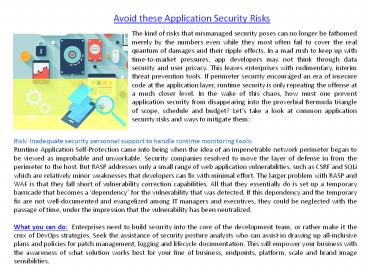Avoid these Application Security Risks - PowerPoint PPT Presentation
Title:
Avoid these Application Security Risks
Description:
The kind of risks that mismanaged security poses can no longer be fathomed merely by the numbers even while they most often fail to cover the real quantum of damages and their ripple effects. In a mad rush to keep up with time-to-market pressures, app developers may not think through data security and user privacy. This leaves enterprises with rudimentary, interim threat prevention tools. If perimeter security encouraged an era of insecure code at the application layer, runtime security is only repeating the offense at a much closer level. In the wake of this chaos, how must one prevent application security from disappearing into the proverbial Bermuda triangle of scope, schedule and budget? Let’s take a look at common application security risks and ways to mitigate them: – PowerPoint PPT presentation
Number of Views:30
Title: Avoid these Application Security Risks
1
Avoid these Application Security Risks
The kind of risks that mismanaged security poses
can no longer be fathomed merely by the numbers
even while they most often fail to cover the real
quantum of damages and their ripple effects. In a
mad rush to keep up with time-to-market
pressures, app developers may not think through
data security and user privacy. This leaves
enterprises with rudimentary, interim threat
prevention tools. If perimeter security
encouraged an era of insecure code at the
application layer, runtime security is only
repeating the offense at a much closer level. In
the wake of this chaos, how must one prevent
application security from disappearing into the
proverbial Bermuda triangle of scope, schedule
and budget? Lets take a look at common
application security risks and ways to mitigate
them
Risk Inadequate security personnel support to
handle runtime monitoring tools Runtime
Application Self-Protection came into being when
the idea of an impenetrable network perimeter
began to be viewed as improbable and unworkable.
Security companies resolved to move the layer of
defense in from the perimeter to the host. But
RASP addresses only a small range of web
application vulnerabilities, such as CSRF and
SQLi which are relatively minor weaknesses that
developers can fix with minimal effort. The
larger problem with RASP and WAF is that they
fall short of vulnerability correction
capabilities. All that they essentially do is set
up a temporary barricade that becomes a
dependency for the vulnerability that was
detected. If this dependency and the temporary
fix are not well-documented and evangelized among
IT managers and executives, they could be
neglected with the passage of time, under the
impression that the vulnerability has been
neutralized. What you can do Enterprises need
to build security into the core of the
development team, or rather make it the crux of
DevOps strategies. Seek the assistance of
security posture analysts who can assist in
drawing up all-inclusive plans and policies for
patch management, logging and lifecycle
documentation. This will empower your business
with the awareness of what solution works best
for your line of business, endpoints, platform,
scale and brand image sensibilities.
2
Avoid these Application Security Risks
Risk Shortsighted planning Both RASP and WAF are
simply adding a shield to the core of the
application and arent helping build secure
applications. Sooner or later, companies will
have to face the hard decision looming before
them whether to purchase an extended cover of
the compensatory RASP control for the zero-day
vulnerability or approach the developers for a
fix. Small and medium businesses often find it
hard to make a decision on the trade-off between
mounting costs and impediments to business
continuity. What you can do Seek to gain
thorough foresight of the long-term benefits and
limitations of security implementation, products
and tools. Risk mitigation planning is incomplete
without exhaustive threat awareness that also
projects a weighed analysis of defense tactics,
apart from keeping a business aware of contextual
vulnerabilities, evolving threat actors and
perilous practices.
Risk Entrusting complete autonomy with runtime
monitoring Runtime security is designed to keep
out real-time attacks and is known to be highly
inclined to throw up false positives. They could
misinterpret unusual traffic for anomalous
traffic and end up stopping code from execution,
thereby damaging data availability culminating
in a self-inflicted DoS attack of sorts. WAF is
only as intelligent as its signature base and
pattern-matching resource. Which means WAF would
know nothing about what an application does with
a particular user input. It only knows enough to
block out inputs that seemmalicious. As one
would guess, hackers are manufacturing cleverer
attacks that can deceive a WAF filter by posing
as a harmless request. What you can do The
basic mindset to adopt is the synchronization of
people and technologies. Tools are prone to throw
up false positives and cannot be left to decide
how to act. They require continuous monitoring by
a security expert who can interpret the nature of
sophisticated attacks and differentiate them from
say, routine performance testing traffic loads.
3
Avoid these Application Security Risks
Another important takeaway is that while RASP can
give your applications self-protection
capabilities, it also means inviting a hacker
deeper into the stack while there are other means
to lock them out even further outside network
boundaries. Such a situation warrants the
guidance of a security consultant who can instill
a culture of robust, mufti-faceted security
fundamentals that prevents the tilting of your
budget towards a single, apparently imprecise
defense mechanism. Beginning with assistance in
developing secure code, a security posture
assessment can bring you the benefits of an
adroit risk management planning backed by a
custom-built threat profile. While tools are
programmed to look for and block out certain
predefined activity, manual penetration testing
thinks out of the box, mimicking attackers who
try everything they can to dodge standard
intrusion prevention signatures.
Source http//blogs.alephtavtech.com/application-
security/avoid-these-application-security-risks/































